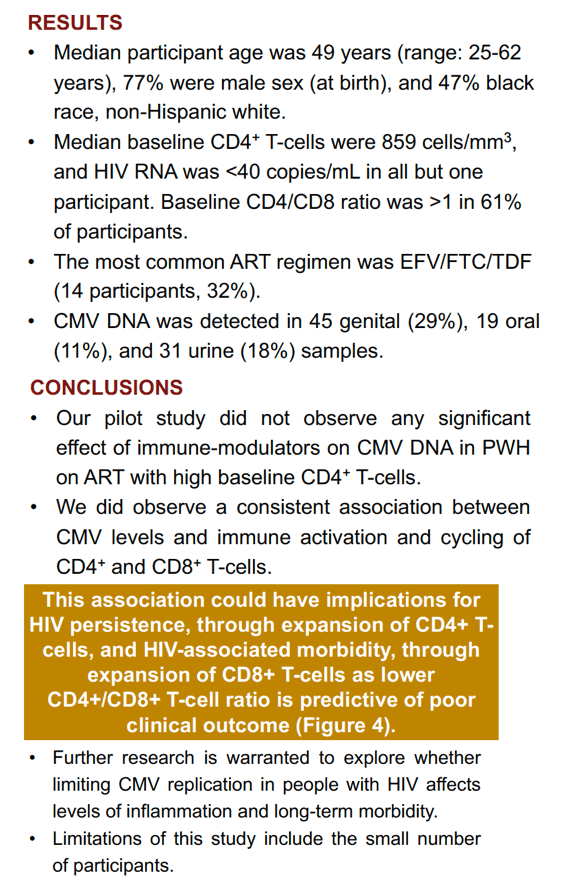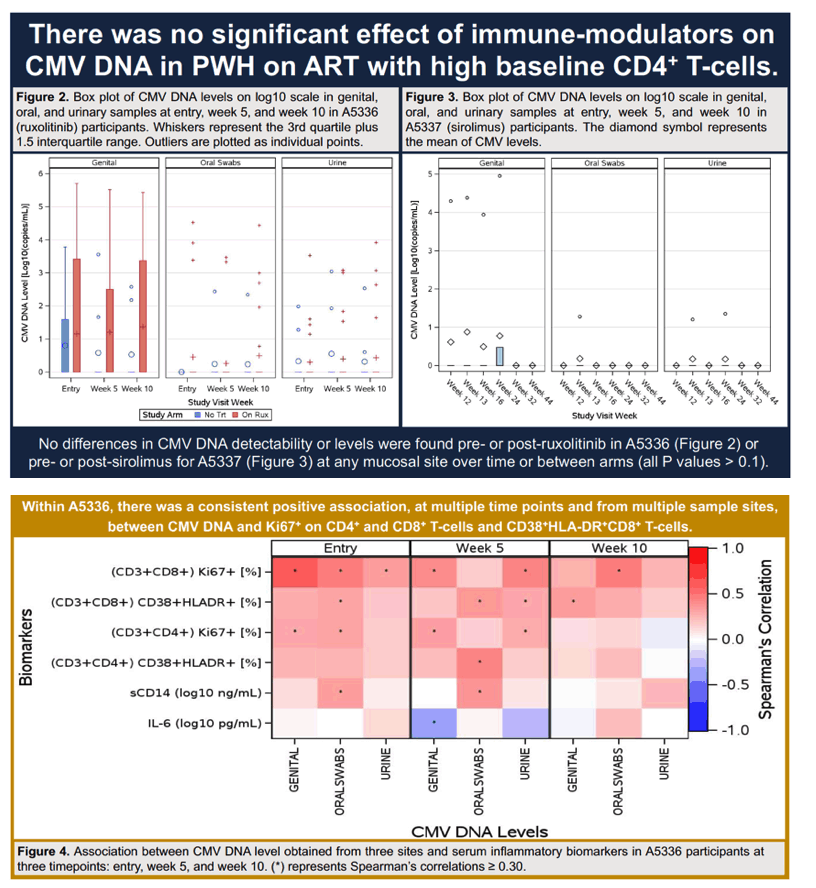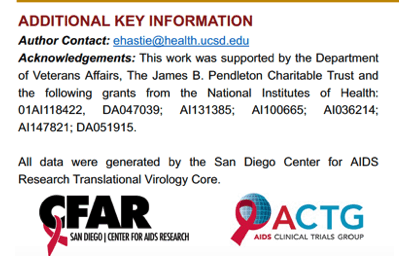 |
 |
 |
| |
ACTG A5351s: Effect of Immune-Modulatory Interventions on CMV Replication during ART
|
| |
| |
There was no apparent effect of either immune-modulatory intervention on CMV DNA (detectability or levels) at any mucosal site over time or between arms.
We did observe a consistent association between CMV levels and immune activation [inflammation] and cycling of CD4+ and CD8+ T-cells, which could have implications for HIV persistence (through expansion of CD4+ T-cells) and HIV-associated morbidity (through expansion of CD8+ T-cells as lower CD4+/CD8+ T-cell ratio is predictive of poor clinical outcome).
CROI 2022 Feb 11-16
Elizabeth Hastie1, Carlee Moser2, Xin Sun2, Jeffrey Lennox3, Priscilla Hsue4, Ronald Bosch2, Steven Deeks4, Milenka Vargas1, Michael Lederman5, Peter Hunt4, Timothy Henrich4, Vincent Marconi3, Sara Gianella1
1University of California San Diego, San Diego, CA, USA, 2Harvard T.H. Chan School of Public Health, Boston, USA, 3Emory University, Atlanta, GA, USA, 4University of California San Francisco, San Francisco, CA, USA 5Case Western Reserve University, Cleveland, OH, USA
program abstract
Background:
Two trials explored the effect of immune-modulators on inflammation in people with HIV (PWH) on suppressive ART. A5336 (ruxolitinib vs placebo) revealed decreased immune activation (sCD14, CD38+HDR+ on CD4+ T Cells) and cell survival (Bcl-2). A5337 (sirolimus, single arm) revealed decreased cellular cycling (Ki67+) and CD4+ T-cell HIV DNA. Here, we investigate if these immune-modulators affect CMV DNA to elucidate a possible contributing effect of CMV replication on inflammatory outcomes.
Methods:
A subset of participants from A5336 (N=36, 509 samples) and A5337 (N=8, 126 samples) were co-enrolled in this study (A5351s). Genital secretions, oral swabs, and urine were assayed for CMV DNA by qPCR at baseline and longitudinally (5 timepoints over 12 weeks for A5336; 6 timepoints over 44 weeks for A5337). Immunological biomarkers from A5336 included IL-6, sCD14, Ki67+, and CD38+HLA-DR+ on T-cells. Correlations between CMV DNA and biomarkers were examined at study entry and week 5 and 10 by Spearman's correlations.
Results:
Median participant age was 49 years (range: 25-62), 77% were male sex (at birth) and 47% black race, non-Hispanic. Median baseline CD4+ T-cells were 859 cells/mm3. CMV DNA was detected in 45 genital (29%), 19 oral (11%), and 31 urine (18%) samples and was more commonly detected in men than in women (31% vs 3%). There was no apparent effect of either immune-modulatory intervention on CMV DNA (detectability or levels) at any mucosal site over time or between arms (all P values >0.1). Detectable CMV DNA in all post-baseline time points in A5336 was 25% in the placebo arm and 31% in the ruxolitinib arm (genital secretion), 8% and 13% (oral swabs), and 24% and 15% (urine). Similarly, no difference in CMV DNA was found pre and post Sirolimus for A5337. Within A5336, there was a consistent positive association between CMV DNA and Ki67+ on CD4+ and CD8+ T-cells (r between 0.30-0.62) and CD38+HLA-DR+CD8+ T-cells (r between 0.31-0.37) at multiple time points and from multiple sample sites (see Table 1).
Conclusion:
Our pilot study did not observe any significant effect of immune-modulators on CMV DNA in PWH on ART with high baseline CD4+ T-cells. We did observe a consistent association between CMV levels and immune activation and cycling of CD4+ and CD8+ T-cells, which could have implications for HIV persistence (through expansion of CD4+ T-cells) and HIV-associated morbidity (through expansion of CD8+ T-cells as lower CD4+/CD8+ T-cell ratio is predictive of poor clinical outcome).





|
| |
|
 |
 |
|
|